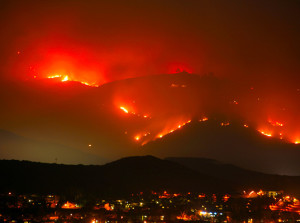Contaminated Water – Another Byproduct of Wildfires
California is no stranger to wildfires but this year has seen a significant increase in wildfire incidents. In 2013, there were 4,243 wildfires that burned almost 115,000 acres of land and already this season California has seen over 5,000 wildfires. We are all well aware of the impact wildfires have on deforestation and property damage but there is another byproduct of wildfires that we need to take into consideration – contaminated drinking water. Not only  does California have to contend with drought conditions and water shortages, now they need to be concerned about the quality of the drinking water they do have.
does California have to contend with drought conditions and water shortages, now they need to be concerned about the quality of the drinking water they do have.
Typically when you are talking about wildfires and water in the same context, the focus tends to be on the increased danger of flooding and mudslides due to runoff but there is much more to it than that. There is a tremendous amount of debris generated during a wildfire and that debris flow way too often ends up in lakes, streams and reservoirs. The debris causes increased sediment in the water supply and it is a monumental task to filter and remove the debris and sediment at a water treatment facility. Some wildfires have deposited so much debris and sediment into the water supply that the drinking water continues to be unpotable years afterward.
In conjunction with the increased sediment and turbidity of the water, there is also an increased concentration of chemicals that gets washed downstream into the water supply. Water quality studies have shown that post wildfire, there is a substantial increase of phosphorus and nitrogen found in the water and that remains there for years. In one key study conducted at the San Dimas Experimental Forest in Glendora, California, they discovered nitrate concentration in streams were ten times over the federal limit for nitrate concentrations – three years after the initial fire!
Phosphorous and nitrates occur naturally in a wildfire, but oftentimes the chemicals that firefighters use to extinguish wildfires find their way into water supplies as well. Drinking water that is contaminated with any of these chemicals can be potentially hazardous to residents and steps need to be taken to ensure that they are not ingesting them. Water treatment facilities work overtime to try and safeguard against contaminated water, but all too often trace amounts or more of these contaminants sneak through. Residents that drink well water are at particular risk for excessive water contamination and it is imperative they install a water filtration system to protect themselves.
A reverse osmosis (RO) drinking water system adds that extra layer of protection for homeowners and their families. RO drinking water systems do a fantastic job of filtering out any unwanted chemicals including nitrates, phosphorous and chlorine by products that can be produced from the need of over processing at a water treatment facility. The Centers for Disease Control (CDC) rate RO systems with very high effectiveness for removing protozoa, bacteria, viruses, sodium, chloride, copper, chromium, lead, arsenic, fluoride, radium, sulfate, calcium, magnesium, potassium, nitrates and phosphorous. Homeowners can be assured that the water they are drinking is as safe and natural as possible and free from harmful contaminants that can be produced from wildfires.


